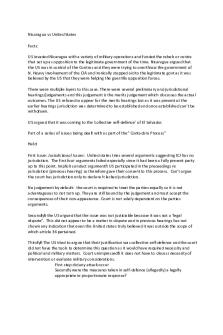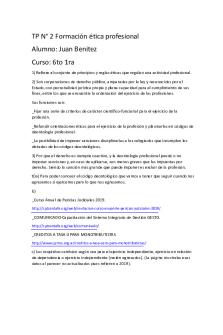Citizen\'s United vs FEC PDF

| Title | Citizen\'s United vs FEC |
|---|---|
| Author | Lindsey Knight |
| Course | Political Science |
| Institution | Washington State University |
| Pages | 7 |
| File Size | 80.3 KB |
| File Type | |
| Total Downloads | 39 |
| Total Views | 174 |
Summary
Important Supreme Court Case...
Description
Facts of the case (Citizens United v FEC) Citizens United sought an injunction against the Federal Election Commission in the United States District Court for the District of Columbia to prevent the application of the Bipartisan Campaign Reform Act (BCRA) to its film Hillary: The Movie . The Movie expressed opinions about whether Senator Hillary Rodham Clinton would make a good president. In an attempt to regulate "big money" campaign contributions, the BCRA applies a variety of restrictions to "electioneering communications." Section 203 of the BCRA prevents corporations or labor unions from funding such communication from their general treasuries. Sections 201 and 311 require the disclosure of donors to such communication and a disclaimer when the communication is not authorized by the candidate it intends to support. Citizens United argued that: 1) Section 203 violates the First Amendment on its face and when applied to The Movie and its related advertisements, and that 2) Sections 201 and 203 are also unconstitutional as applied to the circumstances. The United States District Court denied the injunction. Section 203 on its face was not unconstitutional because the Supreme Court in McConnell v. FEC had already reached that determination. The District Court also held that The Movie was the functional equivalent of express advocacy, as it attempted to inform voters that Senator Clinton was unfit for office, and thus Section 203 was not unconstitutionally applied. Lastly, it held that Sections 201 and 203 were not unconstitutional as applied to the The Movie or its advertisements. The court reasoned that the McConnell decision recognized that disclosure of donors "might be unconstitutional if it imposed an unconstitutional burden on the freedom to associate in support of a particular cause," but those circumstances did not exist in Citizen United's claim.
Question 1) Did the Supreme Court's decision in McConnell resolve all constitutional as-applied challenges to the BCRA when it upheld the disclosure requirements of the statute as constitutional?
2) Do the BCRA's disclosure requirements impose an unconstitutional burden when applied to electioneering requirements because they are protected "political speech" and not subject to regulation as "campaign speech"? 3) If a communication lacks a clear plea to vote for or against a particular candidate, is it subject to regulation under the BCRA? 4) Should a feature length documentary about a candidate for political office be treated like the advertisements at issue in McConnell and therefore be subject to regulation under the BCRA?
Conclusion The BCRA’s restrictions on advertisements regarding Citizens United’s film "Hillary" do not violate the First Amendment. The First Amendment protects the right to free speech, despite the speaker’s corporate identity.
No. No. Yes. Yes. The Supreme Court overruled Austin v. Michigan Chamber of Commerce and portions of McConnell v. FEC . (In the prior cases, the Court had held that political speech may be banned based on the speaker's corporate identity.) By a 5-to-4 vote along ideological lines, the majority held that under the First Amendment corporate funding of independent political broadcasts in candidate elections cannot be limited. Justice Anthony M. Kennedy wrote for the majority joined by Chief Justice John G. Roberts and Justices Antonin G. Scalia, Samuel A. Alito, and Clarence Thomas. Justice John Paul Stevens dissented, joined by Justices Ruth Bader Ginsburg, Stephen G. Breyer, and Sonia Sotomayor. The majority maintained that political speech is indispensable to a democracy, which is no less true because the speech comes from a corporation. The majority also held that the BCRA's disclosure requirements as applied to The Movie were constitutional, reasoning that disclosure is justified by a "governmental interest" in providing the "electorate with information" about election-related spending resources. The Court also upheld the disclosure requirements for political advertising sponsors and it upheld the ban on direct contributions to candidates from corporations and unions. In a separate concurring opinion, Chief Justice Roberts, joined by Justice Alito, emphasized the care with which the Court handles constitutional issues and its attempts to avoid constitutional issues when at all possible. Here, the Court had no narrower grounds upon which to rule,
except to handle the First Amendment issues embodied within the case. Justice Scalia also wrote a separate concurring opinion, joined by Justices Alito and Thomas in part, criticizing Justice Stevens' understanding of the Framer's view towards corporations. Justice Stevens argued that corporations are not members of society and that there are compelling governmental interests to curb corporations' ability to spend money during local and national elections.
Facts of the case (Tinker v Des Moines)
In December 1965, a group of students in Des Moines held a meeting in the home of 16-year-old Christopher Eckhardt to plan a public showing of their support for a truce in the Vietnam war. They decided to wear black armbands throughout the holiday season and to fast on December 16 and New Year's Eve. The principals of the Des Moines school learned of the plan and met on December 14 to create a policy that stated that any student wearing an armband would be asked to remove it, with refusal to do so resulting in suspension. On December 16, Mary Beth Tinker and Christopher Eckhardt wore their armbands to school and were sent home. The following day, John Tinker did the same with the same result. The students did not return to school until after New Year's Day, the planned end of the protest. Through their parents, the students sued the school district for violating the students' right of expression and sought an injunction to prevent the school district from disciplining the students. The district court dismissed the case and held that the school district's actions were reasonable to uphold school discipline. The U.S. Court of Appeals for the Eighth Circuit affirmed the decision without opinion.
Question Does a prohibition against the wearing of armbands in public school, as a form of symbolic protest, violate the students' freedom of speech protections guaranteed by the First Amendment?
Conclusion 7–2 DECISION FOR TINKER
Yes. Justice Abe Fortas delivered the opinion of the 7-2 majority. The Supreme Court held that the armbands represented pure speech that is entirely separate from the actions or conduct of those participating in it. The Court also held that the students did not lose their First Amendment rights to freedom of speech when they stepped onto school property. In order to justify the suppression of speech, the school officials must be able to prove that the conduct in question would "materially and substantially interfere" with the operation of the school. In this case, the school district's actions evidently stemmed from a fear of possible disruption rather than any actual interference.
In his concurring opinion, Justice Potter Stewart wrote that children are not necessarily guaranteed the full extent of First Amendment rights. Justice Byron R. White wrote a separate concurring opinion in which he noted that the majority's opinion relies on a distinction between communication through words and communication through action. Justice Hugo L. Black wrote a dissenting opinion in which he argued that the First Amendment does not provide the right to express any opinion at any time. Because the appearance of the armbands distracted students from their work, they detracted from the ability of the school officials to perform their duties, so the school district was well within its rights to discipline the students. In his separate dissent, Justice John M. Harlan argued that school officials should be afforded wide authority to maintain order unless their actions can be proven to stem from a motivation other than a legitimate school interest.
Federalist 70
In this Federalist Paper, Alexander Hamilton argues for a strong executive leader, as provided for by the Constitution, as opposed to the weak executive under the Articles of Confederation. He asserts, “energy in the executive is the leading character in the definition of good government. It is essential to the protection of the community against foreign attacks…to the steady administration of the laws, to the protection of property…to justice; [and] to the security of liberty….” Though some had called for an executive council, Hamilton defended a single executive as “far more safe” because “wherever two or more persons are engaged in any common…pursuit, there is always danger of difference of opinion…bitter dissensions are apt to spring. Whenever these happen, they lessen the respectability, weaken the authority.” Hamilton also argued that a single executive would be watched “more narrowly” and vigilantly by the people than a group of people would be.
Letter from Birmingham Jail Dr. King was arrested and sent to jail for protesting segregation in Birmingham, Alabama. After reading an open letter from eight white clergymen in the local newspaper criticizing him and his fellow activists, MLK decided he might as well write back to let them know what was on his mind. Enter: letter to the editor. The Text Turns out he had a lot on his mind, and that he hadn't just shown up to the protest to get out of preaching to his congregation for a few days. He had a philosophy and a plan and everything. Dr. King used the opportunity to bring everybody up to speed about the protests in Birmingham, what they were about (horrible systemic racism), why the protestors were civilly disobeying (racist) laws and ordinances, why the protestors had truth and justice (and Jesus/America) on their side, and how Dr. King was disappointed with clergymen
in the South and so-called white moderates who supposedly believed in his cause but didn't like the "tension" and unrest caused by the protests. Get off the couch, get out in the streets, and protest injustice with civil disobedience and love....
Similar Free PDFs

Citizen\'s United vs FEC
- 7 Pages

Nicaragua vs United States
- 6 Pages

Citizens-Charter- Tacolod
- 11 Pages

United Airline
- 9 Pages

TY BMM Notes Senior Citizens
- 4 Pages

United States v. Morrison
- 1 Pages

Dennis v. United States
- 2 Pages

United states thansk giving
- 3 Pages

United States v. O\'Brien
- 2 Pages

SAP PT. United Tractor
- 10 Pages
Popular Institutions
- Tinajero National High School - Annex
- Politeknik Caltex Riau
- Yokohama City University
- SGT University
- University of Al-Qadisiyah
- Divine Word College of Vigan
- Techniek College Rotterdam
- Universidade de Santiago
- Universiti Teknologi MARA Cawangan Johor Kampus Pasir Gudang
- Poltekkes Kemenkes Yogyakarta
- Baguio City National High School
- Colegio san marcos
- preparatoria uno
- Centro de Bachillerato Tecnológico Industrial y de Servicios No. 107
- Dalian Maritime University
- Quang Trung Secondary School
- Colegio Tecnológico en Informática
- Corporación Regional de Educación Superior
- Grupo CEDVA
- Dar Al Uloom University
- Centro de Estudios Preuniversitarios de la Universidad Nacional de Ingeniería
- 上智大学
- Aakash International School, Nuna Majara
- San Felipe Neri Catholic School
- Kang Chiao International School - New Taipei City
- Misamis Occidental National High School
- Institución Educativa Escuela Normal Juan Ladrilleros
- Kolehiyo ng Pantukan
- Batanes State College
- Instituto Continental
- Sekolah Menengah Kejuruan Kesehatan Kaltara (Tarakan)
- Colegio de La Inmaculada Concepcion - Cebu





